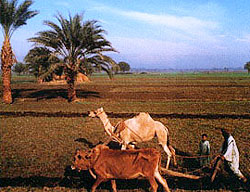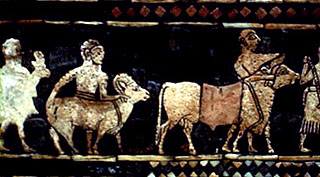 For example, the Near East, the cradle lands of both Western and Islamic civilizations, used animals almost from the beginning of settled life both for food and for labor. This was not accidental. The reasons for this cultural adaptation can be seen in terms of the special needs of Near Eastern cereal-growers: wheat and barley require elaborate (labor-intensive) preparation of the fields (seed beds) so that the grain will out-compete weeds. Using animals-- almost any large animal will do--to drag a scratch plow makes the job easier and quicker for humans. Near Eastern cereal-growers thus became livestock raisers.
For example, the Near East, the cradle lands of both Western and Islamic civilizations, used animals almost from the beginning of settled life both for food and for labor. This was not accidental. The reasons for this cultural adaptation can be seen in terms of the special needs of Near Eastern cereal-growers: wheat and barley require elaborate (labor-intensive) preparation of the fields (seed beds) so that the grain will out-compete weeds. Using animals-- almost any large animal will do--to drag a scratch plow makes the job easier and quicker for humans. Near Eastern cereal-growers thus became livestock raisers.
 An even more fundamental reason for the presence of animals in Near Eastern agriculture, however, derives from the nutritional value of cereal grains. Humans need 12 amino acids to survive and reproduce. Cereal grains, however, supply adequate quantities of only two of the 12. Cereal diets must therefore be supplemented with protein from other sources.
An even more fundamental reason for the presence of animals in Near Eastern agriculture, however, derives from the nutritional value of cereal grains. Humans need 12 amino acids to survive and reproduce. Cereal grains, however, supply adequate quantities of only two of the 12. Cereal diets must therefore be supplemented with protein from other sources.
Animal protein from meat or milk products is one way to create a sustaining diet based on cereals, and this was part of the answer in the Near East. Lentils and dry peas, chick peas (or garbanzos) eventually provided other good supplements found in ancient diets in the region. Another food source is visible in the background of the photo at top left: the date palm. The Greeks relied heavily on olives, both green and ripe, the Babylonians raised figs and dates. The Chinese, with a similar cereal economy, domesticated the protein-rich soy bean to supplement the grains in their diet (wheat, millet, rice). Humans also need many vitamins and at least trace amounts of many elements; these needs are met by including in the diet all sorts of edible plants such as onions, garlic, lentils, garbanzos, cabbage, turnips, fruits, and berries, etc.
A wholly distinctive and different agriculture grew up in the New World, in MesoAmerica and South America. Large domestic animals were conspicuously absent in these ancient economies. The explanation for the contrast with the Old World is not hard to find: their main food plants, corn, squash, and beans (add potatoes in South America) provide, if eaten together, all 12 of the necessary amino acids. The supplementary foods grown by early American farmers include tomatoes and peppers, which have spread all over the world since 1492.